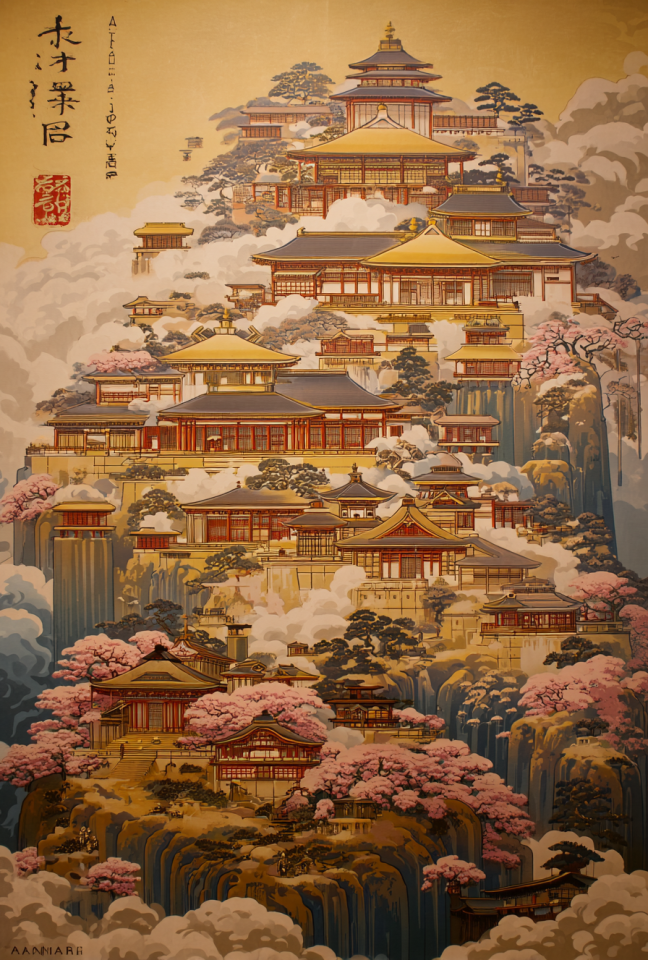Takamagahara — “The Plain of High Heaven” — is the celestial origin-place of the kami, the sacred gods and spirits of Japan. Ruled by Izanagi the divine patriarch and progenitor of the islands, Takamagahara is a realm of balance, ancestry, and light where authority flows from action in harmony with nature rather than domination. It is here that the divine council of kami first assembled, and where Amaterasu, the sun goddess, brought light to the world. Takamagahara sits above the clouds yet below abstraction — not an ethereal void, but a carefully tended celestial realm, radiant but structured, timeless but alive. Once accessible through sacred shrines, mountaintop rituals, and imperial bloodlines, it is now veiled — its radiance hidden, though its patterns echo through the stillness of ritual and the precision of seasonal change.
Landscape and Essence
Takamagahara is an elevated realm of endless light yet it is not formless — its terrain reflects a divine sense of order and grace. Palaces and sacred groves float atop terraces of golden mist, their architecture woven from sunlight, lacquered wood, and silence. Sacred sakura trees bloom perpetually, their petals falling not with decay but as divine punctuation. Crystalline rivers flow upward and sideways, carrying memory and intent rather than water. Bridges of cloudstone link noble dwellings, while bronze bells chime with the passage of divine thought. The realm is both exquisitely formal and intimately natural a place where every breath feels like a prayer and every gesture echoes through the weave of worlds.
Inhabitants
At its center stands Izanagi ancient and calm, the father of islands, rivers, and deities. Though he once traveled the underworld and shed sorrow with each step, in Takamagahara he remains untouched by death — a being of purposeful quietude. Around him move the great kami: Amaterasu radiant sun sovereign; Tsukuyomi lord of the moon and rhythm; Susanoo stormbringer and challenger; and many others — each embodying a natural law or emotional essence. Unlike in some other realms, divine discord here is channeled into ritual not chaos. Attendants of light, elemental spirits, and ancestral guardians populate the realm, all living within a cosmic bureaucracy tempered by beauty. No one here rules for themselves — they enact cosmic story.
Cultural Significance
To the Japanese people, especially in Shinto belief, Takamagahara was the celestial mirror of Japan’s divine potential. It offered a metaphysical origin not only for the land but for lineage, tradition, and ethical order. The emperor’s line was traced to Amaterasu, whose palace here gleams with radiant serenity. Takamagahara shaped ceremonies, dictated festival timing, and infused natural events with sacred undertones. Its memory lives on in shrines seasonal rites and imperial regalia said to descend from its vaults. With the erosion of belief and the rise of secular order, the realm faded from popular imagination — but it did not vanish. It withdrew behind the Veil, preserved by ritualists, remembered in silence.
Role in the Divine Realm
Takamagahara is the administrative and ceremonial heart of the Eastern Divine Realms — a place of initiation, judgment, and reconnection. While realms like Baro Them embrace chaos and celebration, Takamagahara emphasizes ritual clarity where divine conflict is resolved not by war but by myth enacted in form. It upholds the fabric of seasonal time, natural law, and honorable behavior across realms. When cosmic unrest stirs, it is often Takamagahara that records the infraction not with wrath, but with measured realignment.
Interactions with Other Realms
Takamagahara once tethered closely to the Mortal Realm — through mountain shrines, spirit forests, and oracular mirrors. Its divine threads ran through rites of purification ancestral worship and imperial oaths. As foreign ideologies and modern cynicism thinned the public thread of ritual, the gates to Takamagahara slowly dissolved. The Veil here is not opaque, but translucent — when one bows at a shrine with open heart, when a festival perfectly aligns with the season’s soul, Takamagahara stirs. It remains one of the most stable Divine Realms — its harmony preserved by continuity, its silence broken only by grace.
















